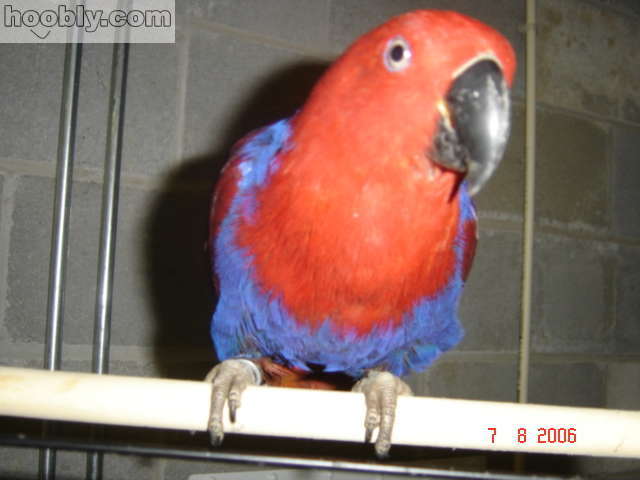Eclectus Parrot - Red Sided
New Guinea Eclectus Scientific Name: Eclectus roratus polychloros
Mon, 14th July, 2025 - 8:06 pm GMT
Sponsor Ads:

Alternative Name
New Guinea Eclectus Scientific Name: Eclectus roratus polychlorosBasic Info
At maturity, Red Sided Eclectus Parrots measure between 33 and 37 centimeters in length and have a wingspan of about 260 millimeters. The feathering of Eclectus Parrots has a strange texture, and has been described as "hair-like". Male Red Sided Eclectus Parrots have yellowish-green feathering over the majority of their bodies. Their primary wing coverts and primary flight feathers are a dark blue color, edged in green. The upperside of the Red Sided Eclectus male's tail is green and the tips of the feathers have yellow edging. The underside of the tail is black, edged with a slight band of pale yellow. The iris is a reddish orange color. Female Red Sided Eclectus Parrots have red plumage with dark blue underwing coverts. They also have a band running to the nape that is dark blue. Females have dark blue, green-edged primary coverts and primary flight feathers like the male, as well. The tips of their red tails have pale edging, and their irises are a light, yellow-white color. Female Red Sided Eclectus Parrots tend to have bright, scarlet heads with a duller, deeper, maroon shading over their backs.
Health
Red Sided Eclectus Parrots are often prone to feather plucking. To prevent this, allow the birds plenty of items to chew and try to prevent them from becoming bored. Feather plucking may also be brought on by enclosures that are too small, stress, bullying, dietary changes, or climatic changes. Some Red Sided Eclectus Parrots will only pluck at certain times of the year. Eclectus Parrots have a longer digestive tract than any other parrot, and they need more fresh veggies and fruits than most parrots. Breeding Generally, Red Sided Eclectus Parrots breed year round. They reach sexual maturity between two and three years of age. When she is about to breed, the female Eclectus may become quite aggressive, even toward her handler. Before laying, the female will generally spend a lot of time fussing in her nest box to arrange it suitably. She will usually lay two eggs. Because female Red Sided Eclectus Parrots will often sit on their eggs awkwardly or forcefully and accidentally break them, a slanted or L shaped nesting box is recommended so the birds have room to position themselves better. The female Red Sided Eclectus Parrot will incubate her eggs for about four weeks before they hatch. The fledglings will develop sexually dimorphic coloration by the time they are about 28 days old. Usually, they will leave the nest by 75 days of age.Habitat
N/ABehavior
The Red Sided Eclectus Parrot is one of the most popular Eclectus species kept by aviculturalists, and it is not difficult to see why. With their intensely shaded coloring and their lovely personalities, Red Sided Eclectus Parrots are truly incredible birds. In the wild, Red Sided Eclectus Parrots nest high in the forest canopy. Pairs will usually predominate in a group, with other parrots in the group helping the dominant pair to raise their young. In captivity, they tend to do well when kept in pairs. When kept outdoors, a four and a half-meter by one and a fifth meter by two-meter aviary in a sheltered area will suffice for a pair. These birds are quite loud, but they can make good pets for people who will tolerate the noise. One trick to make your birds be a bit quieter can be to turn on a radio for them, to keep them from providing their own noise! Red Sided Eclectus Parrots can be taught to imitate noises and talk quite well. They need plenty of sunlight and enjoy being bathed by rain! Generally, hand raised parrots make much better, healthier pets than will wild-caught birds.Origin
New GuineaHistory
Red Sided Eclectus Parrots are native to New Guinea and the surrounding islands, including the D'Entrecasteaux Archipelago and the Lousiada Archipelago. They are also known as New Guinea Eclectus Parrots. This species is one of the most commonly kept species of Eclectus Parrots in captivity. The Red Sided Eclectus Parrot was first recorded by Scopoli in 1786. It was, in fact, the first subspecies of Eclectus Parrot to be noted after the discovery of the nominate species, the Grand Eclectus. Eclectus Parrot pairs are often mistaken for two birds of different species, since their coloration is so vastly different.Common Foods
Red Sided Eclectus Parrots may be fed plenty of fresh fruits and vegetables along with a good basic pellet diet or seed mix. The majority of the seeds should be soaked to make them softer for the parrots. Plenty of branches or wood should be provided forSponsor Ads:
Thoughts on Programming, Number 37: Neither function alone nor simplicity alone defines a good design. -The Mythical Man-Month Frederick P. Brooks, Jr.
Eclectus Parrot - Red Sided
Coded by: BGID® | ALL RIGHTS RESERVED Copyright © 2000-2025
Disclaimer | Privacy | Report Errors / Contact | Credits








 Preparing For China. China is growing their military. China Military Technology - can it keep up with the US?
Preparing For China. China is growing their military. China Military Technology - can it keep up with the US?  versus
versus 

 versus
versus 
 This Thread is about the North Korean Military itself - the kind of army, navy, and air force they have.
This Thread is about the North Korean Military itself - the kind of army, navy, and air force they have. 
 versus
versus 
 versus
versus  versus
versus